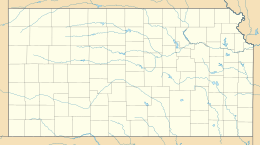Pottawatomie massacre
| Pottawatomie massacre | |
|---|---|
| Part of Bleeding Kansas | |
| Location | Franklin County, Kansas |
| Date | May 24–25, 1856 |
| Target | Pro-slavery settlers |
|
Attack type
|
Slashing, shooting |
| Deaths | 5 |
| Perpetrator |
Abolitionists Pottawatomie Rifles |
The Pottawatomie massacre occurred during the night of May 24 and the morning of May 25, 1856. In reaction to the sacking of Lawrence, Kansas by pro-slavery forces, John Brown and a band of abolitionist settlers—some of them members of the Pottawatomie Rifles—killed five settlers north of Pottawatomie Creek in Franklin County, Kansas. This was one of the many bloody episodes in Kansas preceding the American Civil War, which came to be known collectively as Bleeding Kansas. Bleeding Kansas was largely brought about by the Missouri Compromise and the Kansas–Nebraska Act.
John Brown was particularly affected by the sacking of Lawrence, in which a sheriff-led posse destroyed two abolitionist newspaper offices, the fortified Free State Hotel, and the house of Charles Robinson, the free-state militia commander-in-chief and leader of the Free State government established in opposition to the pro-slavery Territorial Government. A Douglas County grand jury had ordered the abatement because the hotel "had been used as a fortress" and an "arsenal" the previous winter and the "seditious" newspapers were indicted because "they had urged the people to resist the enactments passed" by the territorial governor. The violence against abolitionists was accompanied by celebrations in the pro-slavery press, with writers such as Dr. John H Stringfellow of the Squatter Sovereign proclaiming that pro-slavery forces "are determined to repel this Northern invasion and make Kansas a Slave State; though our rivers should be covered with the blood of their victims and the carcasses of the Abolitionists should be so numerous in the territory as to breed disease and sickness, we will not be deterred from our purpose." Brown was outraged by both the violence of pro-slavery forces, and also by what he saw as a weak and cowardly response by the antislavery partisans and the Free State settlers, whom he described as cowards, or worse. In addition, two days before this massacre Brown learned about the caning of abolitionist Charles Sumner by Preston Brooks on the floor of Congress.
...
Wikipedia

